11 Questions about Modes Answered!
We want to you better understand the modes, and how you can use them for your own songs, compositions, and improvisations, helping you become better, a more unique player! With that said, let’s get started!
We gathered up all the questions most students on the internet ask about the modes, and we will address the most frequently asked questions below.
1. What are the modes? I've heard about them, and people are always talking about this, or that mode?
Modes are simply scales that exist inside scales, with unique harmonic and melodic characteristiscs. Think of it this way; you have a house, the house is the major scale. Inside the house are struts, joists, walls, doors, each could be a mode. Each one of these things is important enough to have it’s own name and function, but it exists inside a house.
Inside a major scale, let’s say C major, there are 7 modes. Each one is found by playing C major, but starting on a different pitch. C major is the house, and all the modes are parts of the house. You must know the notes that make C major to understand the modes you are accessing. Like building a house, you must have the blueprint.
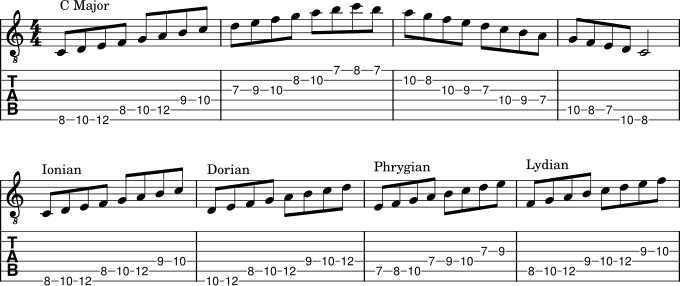

Know Your Stuff, Really!
Experience through teaching has shown me that although most students claim to understand how this scale/mode relationship works, they really don’t. They twist it up into a weird pretzel, when they don’t understand the basics. You must know the notes of the major scale, so let’s start there.
The example shows all the notes of the major scale, and all the modes you can construct using the major scale, but starting on different pitches. Starting on D gets us Dorian mode, starting on E we get phrygian, F is lydian, G we have mixolydian, A is aeolian mode, and finally B is locrian. Like the analogy with the house, musically, what we have here are scales within scales.
Read our article here about understanding major 7th chords.
2. Scales within scales? What does that mean?
We try to act like we’re a big deal by making up all these important names and schemes so non-musicians have to scratch their heads. It’s not a big thing at all. Basically what this means is that each one of these modes has it’s own set of chords and harmonic colors that make it totally unique. When you’re writing or improvising, you may be accessing sounds that use these modes and not even know it. If you dedicate time to study the unique sounds and chord structures you can get using modes, you’ll find that you can create intesresting color that isn’t easily found using just major and minor chord/scale theory.
3. What's the difference between scales and modes? It's confusing!
See my answer above about complex names for simple things. Too keep things simple for myself and my students, I think about it this way: if it carries tonic/dominant or classical music characteristics, it’s a scale. Anything else is a mode. Major, Minor, Melodic Minor, and Harmonic Minor and Major are scales. All the stuff you can generate based on those 5 scales are modes. Dorian flat 9 is a mode, based on melodic minor. Ionian #5 is a mode based on harmonic minor.
4. How are the modes constructed?
They exist inside of scales. If I want to play G dorian, I need to know what scale that mode belongs to. Since dorian is the 2nd mode (see question 1 above) of the major scale, that means I am accessing the notes in F major to play G dorian. This is important, because the notes and chord scale relationship will contain all the same notes as F.
If I want to play A lydian augmented, I have to first know that it’s the 3rd mode of the melodic minor scale. I have to also know what ‘home’ this mode belongs to, meaning, what collection of pitches that make the home scale. Lydian augmented is the 3rd mode, so, we’re in accessing the notes of the F# melodic minor scale.
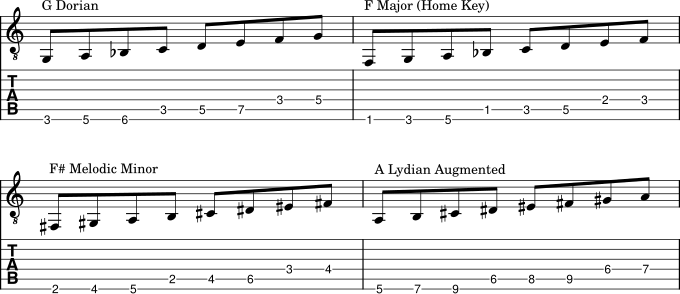
5. How do I use modes?
There are multiple ways to use modes that are all equally ok. Let’s say we are working on a solo section and trying to come up with the perfect thing to play over a riff in E minor. In your toolbox of scales, the typcial scales we as listeners expect are E minor pentatonic, E minor, E minor blues, or some application of all three. One way to use modes is to pick a mode that has enough of the same characteristics as the ‘chord’ of the moment, and use that scale to create licks. Since we’re in E minor, we can use any of the modes that have ‘minor’ character. Within the major scale alone, that gives us E phrygian, E aeolian, E dorian, and E locrian. Each of these scales will carry a different character than the 2 or 3 you would typically use. And again, to find these scales, we need to know and understand the scales they belong to. E phrygian is C major, E aeolian is G major, E dorian is D major, and E locrian is F major.

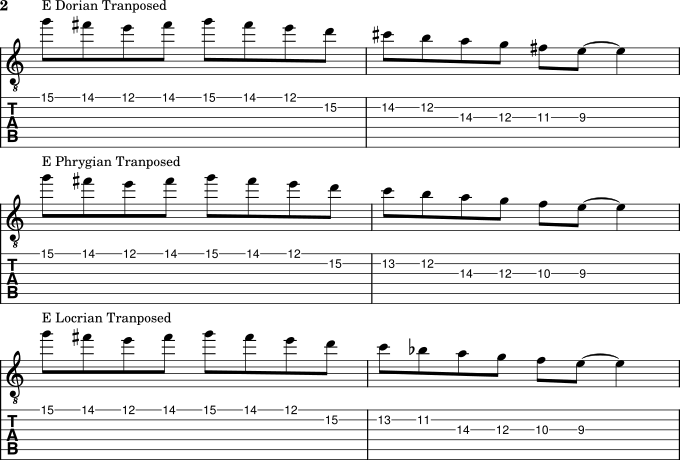
There is another way to access the modes, and that is to use their unique properties to construct chords, and progressions. In order to do this, you need a deeper understading of each mode, and the chords you can create that give you their color.
Let’s go back to D dorian, run through the scale, and stack the scale in 3rds.
We now have D minor, E minor, F, G, A minor, B diminshed, and C. We can construct progressions that target D dorian by using these chords, and for more impact, putting D as the bass note.
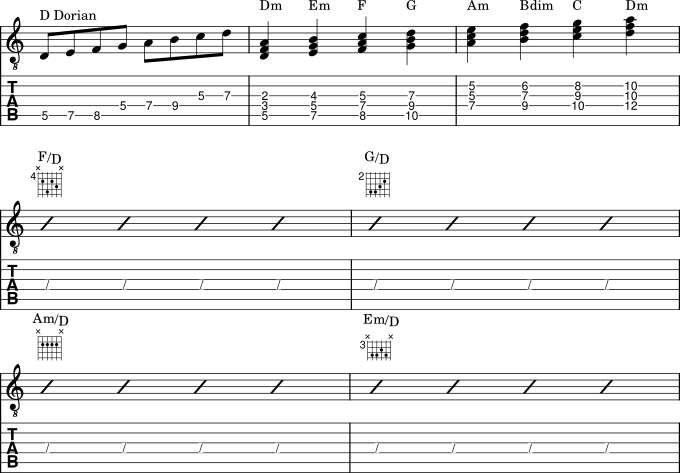
Let’s look at another example of this. I’m going to pick F# phrygian, and construct chords based on that mode. F# phrygian is the 3rd mode in the major scale, it belongs to the home key of D and uses the same notes. We will pick chords in that scale, and place F# in the bass for added emphisis on the mode.
(F# phrygian – D major)
(F#m, G, A, Bm, C# diminished, D, em)
Within these two examples of how to play around with modes, there is a lifetime of chords and color to study and understand. The deeper you go, the more unique your ideas will become. Have fun!
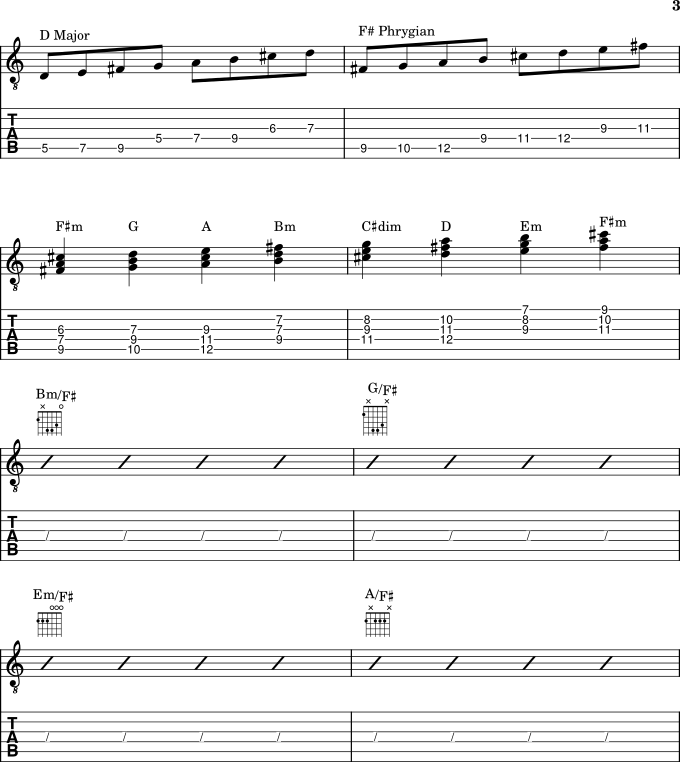
6. How can I tell one mode from the other?
This is where ear training, and knowing your scales come into play. Each mode has it’s own flavors, and you can study each one by playing it, writing it out, and listening to it’s character. Some are major, some are minor. This means the 3rd note in the mode is either natural or flat to make a minor sound. Some modes have the 4th note altered (lydian), or the 7th (dominant/mixolydian) or the 6th, or the 2nd. It’s your job to study these and find combinations you appreciate to build your own palette of sounds. Remember that you can use all this stuff for chord progressions, compositions, solos, everything really.
7. Can I use modes in (my preferred) style?
Yes! Chances are you already are, and don’t know it. If you’re into rock, there are so many examples of mode based rock stuff. Metal espcially uses modes to create riffs and sequences, and in Jazz, most of us that started learning improv using only modes as a means to navigate solos sections. The most common way we use modes in rock is to come up with ideas that don’t typically resolve the way chords progressions do. No tonic to dominant stuff, just jams. If you’re playing something that you’re using to jam through, take turns playing solos, chances are it’s modal. Same with metal. Riffs tend to be modal, and don’t resolve to anything.
8. Can I mix and match modes in the same song?
You totally can. You can use the same mode in a different key to create progressions. Use multiple modes over a single chord in a solo. Use unrelated modes and structures against one another. You can really go nuts with this stuff. It takes time to study, and lots of experimentation, but, it’s worth the effort.
9. What's the difference between Diatonic and Modal music?
The big difference is in Diatonic music, tension is created and resolved by moving chords and motives through tonic to dominant and back again. In modes, this is less so, if not at all. The relationship between tonic and dominant breaks down the farther you get. What happens instead is a tonal palatte unique to the mode, often difficult to resolve in a satisfactory way, and lends itself to exploratory composition and design.
None of this stuff is mutually exclusive. There is much room for experimentation!
10. What is modal mixture? I've heard that phrase?
Oddly enough this dosen’t really have anything to do with the modes, well, not exactly anyway. Modal mixture is when you borrow notes from the parallel minor or major, depending on where you are. If you’re in B major, modal mixture would be borrowed chords from B minor. If you’re in C minor, borrow chords from C major. In a modal context, you could say you’re borrowing from the aeolian, or the ionian.
Can you borrow from any other parallel modes? I bet you can, but this isn’t the scope of what teachers mean when speaking on modal mixture.
11. How do I make my modal chord progressions unique?
Remember that each mode will present intesresting harmonic applications that you can use in your music. Just as we study scales, you should practice your selected mode in 3rds, triads, 7ths, and also with chromatic approaches. Within this you’ll find chords and certain progressions of chords you will gravitate towards. Experimentation is key. Read here about other ways to be creative!
As always, any other questions feel free to contact us here! Thanks!





